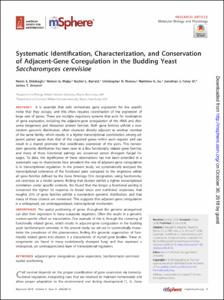Please use this identifier to cite or link to this item:
http://hdl.handle.net/20.500.12164/129| Title: | Systematic identification, characterization, and conservation of adjacent-gene coregulation in the budding yeast Saccharomyces cerevisiae |
| Authors: | Eldabagh, Reem S. Mejia, Nelson G. Barrett, Rachel L. Monzo, Christopher R. So, Matthew K. Foley, Jonathan J., IV Arnone, James T. |
| Keywords: | Adjacent-gene Coregulation;Gene Expression;Saccharomyces Cerevisiae;Spatial Positioning;Biology |
| Issue Date: | 2018 |
| Publisher: | American Society for Microbiology |
| Citation: | Eldabagh RS, Mejia NG, Barrett RL, Monzo CR, So MK, Foley JJ, IV, Arnone JT. 2018. Systematic identification, characterization, and conservation of adjacent-gene coregulation in the budding yeast Saccharomyces cerevisiae. mSphere 3:e00220-18. https://doi.org/10.1128/mSphere.00220-18. |
| Abstract: | It is essential that cells orchestrate gene expression for the specific niche that they occupy, and this often requires coordination of the expression of large sets of genes. There are multiple regulatory systems that exist for modulation of gene expression, including the adjacent-gene coregulation of the rRNA and ribosome biogenesis and ribosomal protein families. Both gene families exhibit a nonrandom genomic distribution, often clustered directly adjacent to another member of the same family, which results in a tighter transcriptional coordination among adjacent paired genes than that of the unpaired genes within each regulon and can result in a shared promoter that coordinates expression of the pairs. This nonrandom genomic distribution has been seen in a few functionally related gene families, and many of these functional pairings are conserved across divergent fungal lineages. To date, the significance of these observations has not been extended in a systematic way to characterize how prevalent the role of adjacent-gene coregulation is in transcriptional regulation. In the present study, we systematically analyzed the transcriptional coherence of the functional pairs compared to the singletons within all gene families defined by the Gene Ontology Slim designation, using Saccharomyces cerevisiae as a model system, finding that clusters exhibit a tighter transcriptional correlation under specific contexts. We found that the longer a functional pairing is conserved the tighter its response to broad stress and nutritional responses, that roughly 25% of gene families exhibit a nonrandom genomic distribution, and that many of these clusters are conserved. This suggests that adjacent-gene coregulation is a widespread, yet underappreciated, transcriptional mechanism. |
| URI: | https://doi.org/10.1128/mSphere.00220-18 http://hdl.handle.net/20.500.12164/129 |
| ISSN: | 2379-5042 |
| Appears in Collections: | Biology |
Files in This Item:
| File | Description | Size | Format | |
|---|---|---|---|---|
| e00220-18.full.pdf | Article | 1.4 MB | Adobe PDF |  View/Open |
This item is licensed under a Creative Commons License

